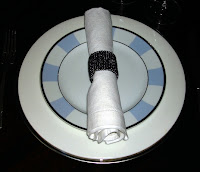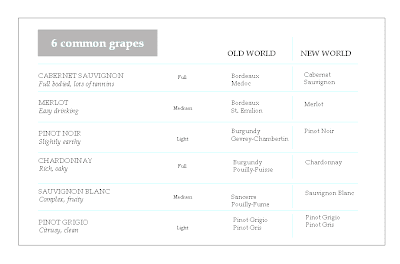Since I seem to be blogging lately with an entertaining theme, I thought I would share my macro-level "swear by" check list when it comes to setting a table. These guiding thoughts are specifically for an occasion, formal or informal, where you are hosting special friends and guests. No, these are not for the everyday mid-week suppers where just sitting down together feels like a huge accomplishment! Consider them just some little touches to help set the perfect stage.
It's funny how differently each one of them was acquired. One was from a general entertaining coffee table book. Two were "learned the hard way." (Yea. I'll get into that.) And best of all, two were passed along from two favored friends who's voices I hear, still to this day, speaking them to me as I open the cupboard to pull out my first plate. A shout out goes to DF and TS!
So here goes...
1. Start on a rich foundation
Before you put down a table cloth, start with a pad. These can be easily and inexpensively purchased at stores like Bed, Bath and Beyond. For me, they work on 2 different levels. First there's the practical level - to protect the table underneath. Spilled liquids or dropped utensils can unexpectedly damage the finish of fine woods. Pads obviously provide an extra buffer. Second, and to me more importantly, is the experience level. This is especially critical if you are using hard thin tables (plywood rentals, molded synthetics, particle board) or even glass. Pads provide a softer platform. As you rest your hands or replace your knife, you feel a little extra something. A richness. Not hugely noticeable, but certainly more enjoyable. There's also the sound barrier. Pads muffle the "tin-y" or hard sounds often made when putting things down on these types of surfaces. Keep the din of conversation the only thing front and center.
2. Always go with the natural fibers
There are so many varieties of table linens out there. I know "from my mother" the benefits of blended and synthetic materials - no ironing, better lasting color, easy drape, did I mention, no ironing? But I just can't do it. The tactile nature is just off. There's nothing like the touch of linen or cotton.
Whether it be starch crisp or loose press, they simply feel more natural, more comfortable. And they also provide better absorbency. Liquids just bead up on the other stuff. I would rather have a spill contained on a napkin or tablecloth versus having it run down onto the chair or carpet. If you don't like to iron, send them to the dry cleaners. They'll launder and return them individually pinned to hangers! Yea, I once tried a synthetic napkin/placemat set with organza trim. Scratchy to wipe the mouth. Little absorbency. A puckered mess once laundered due to cotton thread (shrinkage) used with 2 different (non-shrinkage) materials. Difficult to iron so not to melt the material. Good riddance...
3. Centerpieces above or below
That's above eye level or below. This I had previously "heard" but unfortunately had to learn, again the hard way. Extravagant centerpieces are great for show tables. Those that are on display at Macy's or sponsored for design competitions. Big. Fun. Very dramatic. Now...try sitting down and talking through one. Yea. During the middle of dinner, I had people ask if they could move the centerpiece to the side table.
Um, what do you say? No? My decor is more important? Awkward... Conversation is the name of the game at a successful dinner gathering. It should not be limited to those solely on your right and left. There are those across from you, diagonal to you. Just about anyone within earshot. Nothing inhibits good conversation like an miss-sized centerpiece. For most of us, that's keeping its maximum height below eye level. There are a few who might have trumpet vases or some other device that can elevate the floral mass above eye level. Same objective still holds - keep a clear line of sight for those seated. Period. I wouldn't recommend this elevated option outdoors, though. Consider those trees gently bending in the wind... arrangements don't bend, they just topple over.
4. Think multi-dimensional
Stimulate the eyes. Look for a variety of elements to visually engage your guests. Layered linens, contrasting plates (see post 3/17), and varying heights can independently or together create a symphony of texture and dimension. This is another area to play and discover. For example, if you have a gold or fall theme, consider the addition of amber glass in the form of wine/water glasses or small vases. In order to help punch the blue color in one scape, I once used blue chinoiserie inspired drink coasters with votive candles on top at every place setting. Be creative and go around your house. Check in your prop closet (see Post 2/7). Some items alone may not seem like much. But together, they can create a look that's totally unique.
5. Something new for everyone, everytime
This is a concept I completely embrace. It's basically considering all your guests as repeat visitors. With this in mind, you then will be inspired to continually shake things up. Don't rest on status quo. With each opportunity, make sure everyone experiences something new. Change the color scheme. Go informal. Try a table in another room. Go al fresco. Borrow some new silverware. Keep your friends and family guessing, no matter how often they've been over. It will always make a trip to your house something special.
I must confess there is some merit with the opposite perspective to #5 whereby keeping table setting consistent. A friend of mine once expressed it to me this way - repetition firmly implants that singular image/experience in your mind, a memory. Consider the family dinners at your Grandmother's house. Chances are she served everything on the same china with the same tablecloth, etc. You may not remember a specific day or meal, but you'll always associate that look with her. It's warm. It's comforting. Not my cup of tea, but certainly not a bad way of thinking either. So, #5, I leave it up to you to decide which one works best.
Till the next time...
 |
| To answer any questions about placement. Courtesy of Domino Magazine, sadly out of print |
 |
| End of a perfect evening... |













